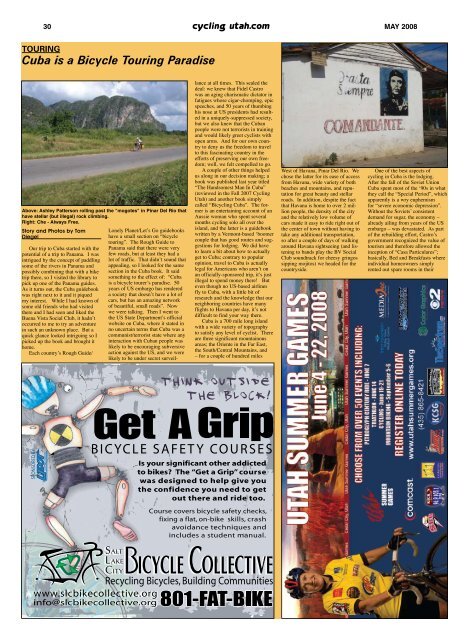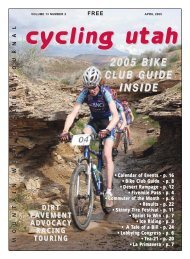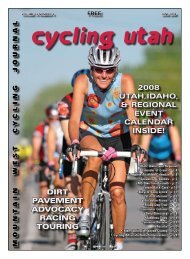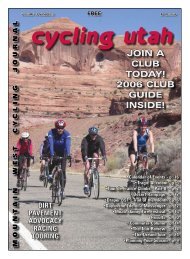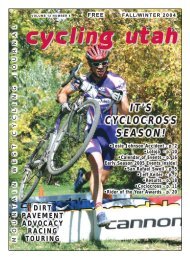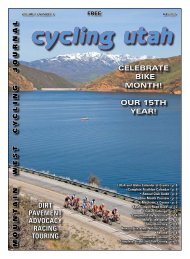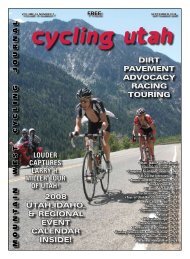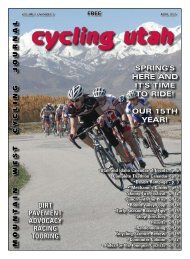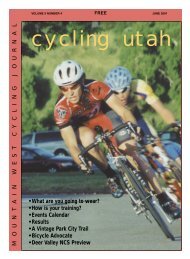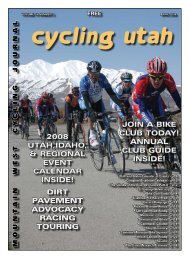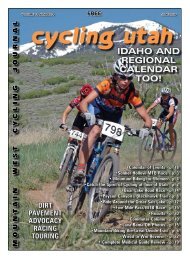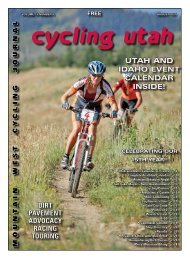Create successful ePaper yourself
Turn your PDF publications into a flip-book with our unique Google optimized e-Paper software.
30 cycling utah.com MAY <strong>2008</strong><br />
touring<br />
Cuba is a Bicycle Touring Paradise<br />
Above: Ashley Patterson rolling past the "mogotes" in Pinar Del Rio that<br />
have stellar (but illegal) rock climbing.<br />
Right: Che - Always Free.<br />
Story and Photos by Tom<br />
Diegel<br />
Our trip to Cuba started with the<br />
potential of a trip to Panama. I was<br />
intrigued by the concept of paddling<br />
some of the rivers in Panama and<br />
possibly combining that with a bike<br />
trip there, so I visited the library to<br />
pick up one of the Panama guides.<br />
As it turns out, the Cuba guidebook<br />
was right next to it and it piqued<br />
my interest. While I had known of<br />
some old friends who had visited<br />
there and I had seen and liked the<br />
Buena Vista Social Club, it hadn’t<br />
occurred to me to try an adventure<br />
in such an unknown place. But a<br />
quick glance looked intriguing so I<br />
picked up the book and brought it<br />
home.<br />
Each country’s Rough Guide/<br />
Lonely Planet/Let’s Go guidebooks<br />
have a small section on “bicycle<br />
touring”. The Rough Guide to<br />
Panama said that there were very<br />
few roads, but at least they had a<br />
lot of traffic. That didn’t sound that<br />
appealing, so I looked for the same<br />
section in the Cuba book. It said<br />
something to the effect of: “Cuba<br />
is a bicycle tourer’s paradise. 50<br />
years of US embargo has rendered<br />
a society that doesn’t have a lot of<br />
cars, but has an amazing network<br />
of beautiful, small roads”. Now<br />
we were talking. Then I went to<br />
the US State Department’s official<br />
website on Cuba, where it stated in<br />
no uncertain terms that Cuba was a<br />
communist/terrorist state where any<br />
interaction with Cuban people was<br />
likely to be encouraging subversive<br />
action against the US, and we were<br />
likely to be under secret surveil-<br />
lance at all times. This sealed the<br />
deal: we knew that Fidel Castro<br />
was an aging charismatic dictator in<br />
fatigues whose cigar-chomping, epic<br />
speeches, and 50 years of thumbing<br />
his nose at US presidents had resulted<br />
in a uniquely-suppressed society,<br />
but we also knew that the Cuban<br />
people were not terrorists in training<br />
and would likely greet cyclists with<br />
open arms. And for our own country<br />
to deny us the freedom to travel<br />
to this fascinating country in the<br />
efforts of preserving our own freedom;<br />
well, we felt compelled to go.<br />
A couple of other things helped<br />
us along in our decision making; a<br />
book was published last year titled<br />
“The Handsomest Man In Cuba”<br />
(reviewed in the Fall 2007 <strong>Cycling</strong><br />
<strong>Utah</strong>) and another book simply<br />
called “Bicycling Cuba”. The former<br />
is an entertaining account of an<br />
Aussie woman who spent several<br />
months cycling solo all over the<br />
island, and the latter is a guidebook<br />
written by a Vermont-based ‘boomer<br />
couple that has good routes and suggestions<br />
for lodging. We did have<br />
to learn a bit about how to actually<br />
get to Cuba; contrary to popular<br />
opinion, travel to Cuba is actually<br />
legal for Americans who aren’t on<br />
an officially-sponsored trip, it’s just<br />
illegal to spend money there! But<br />
even though no US-based airlines<br />
fly to Cuba, with a little bit of<br />
research and the knowledge that our<br />
neighboring countries have many<br />
flights to Havana per day, it’s not<br />
difficult to find your way there.<br />
Cuba is a 700 mile long island<br />
with a wide variety of topography<br />
to satisfy any level of cyclist. There<br />
are three significant mountainous<br />
areas; the Oriente in the Far East,<br />
the South/Central Mountains, and<br />
– for a couple of hundred miles<br />
West of Havana, Pinar Del Rio. We<br />
chose the latter for its ease of access<br />
from Havana, wide variety of both<br />
beaches and mountains, and reputation<br />
for great beauty and stellar<br />
roads. In addition, despite the fact<br />
that Havana is home to over 2 million<br />
people, the density of the city<br />
and the relatively low volume of<br />
cars made it easy to ride right out of<br />
the center of town without having to<br />
take any additional transportation,<br />
so after a couple of days of walking<br />
around Havana sightseeing (and listening<br />
to bands play the BV Social<br />
Club soundtrack for cheesy gringos<br />
sipping mojitos) we headed for the<br />
countryside.<br />
One of the best aspects of<br />
cycling in Cuba is the lodging.<br />
After the fall of the Soviet Union<br />
Cuba spent most of the ‘90s in what<br />
they call the “Special Period”, which<br />
apparently is a wry euphemism<br />
for “severe economic depression”.<br />
Without the Soviets’ consistent<br />
demand for sugar, the economy –<br />
already ailing from years of the US<br />
embargo – was devastated. As part<br />
of the rebuilding effort, Castro’s<br />
government recognized the value of<br />
tourism and therefore allowed the<br />
inception of “Casa Particulares”;<br />
basically, Bed and Breakfasts where<br />
individual homeowners simply<br />
rented out spare rooms in their


